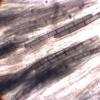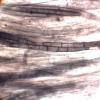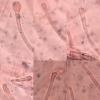
09-11-2025 13:20
Hello.A tiny ascomycete, appearing as erupting gra

08-11-2025 00:29
 Francois Guay
Francois Guay
I found this species in Quebec, Canada, on herbace

04-11-2025 09:07
Hello.A suspected Hymenoscyphus sprouting on a thi

04-11-2025 12:43
 Edvin Johannesen
Edvin Johannesen
Hi! One more found on old Populus tremula log in O

03-11-2025 21:34
 Edvin Johannesen
Edvin Johannesen
These tiny (0.4-0.5 mm diam.), whitish, short-stip
Glutinoglossum
Malcolm Greaves,
05-12-2020 16:04
This sticky specimen has spores from 0-7 septate with about 1/3 being 3, 1/3 being 7 and the final third being split between 0,1,2,4,5 and 6. The average length was 74 (59-84). Both the paraphyses on the head and stem were bulbose and septate.
The best fit I can see is G pseudoglutinosum. Does this seem reasonable?
Thanks
Mal
Sabino Arauzo,
09-12-2020 21:54
Re : Glutinoglossum
Hi Malcolm,
the key in Fedosova et al. 2018 is not useful in all cases.
We have sequenced several collections with predominant 3, 7 or 3-7 septa and all belong to G. glutinosum.
It is almost impossible to distinguish these species without sequencing.
Sabino.
Malcolm Greaves,
10-12-2020 00:52
Re : Glutinoglossum
Thanks for that Sabino. A sample is on its way for DNA.
Does that mean you feel the species in the Fedosova work are not real species or that distinguishing features described are not accurate?
Thanks
Mal
Does that mean you feel the species in the Fedosova work are not real species or that distinguishing features described are not accurate?
Thanks
Mal




